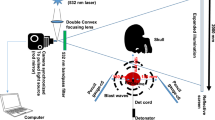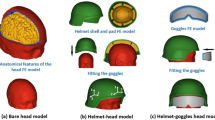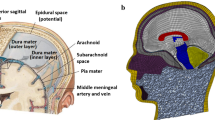Abstract
To combat the problem of traumatic brain injury (TBI), a signature injury of the current military conflicts, there is an urgent need to design head protection systems with superior blast/ballistic impact mitigation capabilities. Toward that end, the blast impact mitigation performance of an advanced combat helmet (ACH) head protection system equipped with polyurea suspension pads and subjected to two different blast peak pressure loadings has been investigated computationally. A fairly detailed (Lagrangian) finite-element model of a helmet/skull/brain assembly is first constructed and placed into an Eulerian air domain through which a single planar blast wave propagates. A combined Eulerian/Lagrangian transient nonlinear dynamics computational fluid/solid interaction analysis is next conducted in order to assess the extent of reduction in intra-cranial shock-wave ingress (responsible for TBI). This was done by comparing temporal evolutions of intra-cranial normal and shear stresses for the cases of an unprotected head and the helmet-protected head and by correlating these quantities with the three most common types of mild traumatic brain injury (mTBI), i.e., axonal damage, contusion, and subdural hemorrhage. The results obtained show that the ACH provides some level of protection against all investigated types of mTBI and that the level of protection increases somewhat with an increase in blast peak pressure. In order to rationalize the aforementioned findings, a shockwave propagation/reflection analysis is carried out for the unprotected head and helmet-protected head cases. The analysis qualitatively corroborated the results pertaining to the blast-mitigation efficacy of an ACH, but also suggested that there are additional shockwave energy dissipation phenomena which play an important role in the mechanical response of the unprotected/protected head to blast impact.














Similar content being viewed by others
References
S. Okie, Traumatic Brain Injury in the War Zone, N. Engl. J. Med., 2005, 352, p 2043–2047
K.H. Taber, D.L. Warden, and R.A. Hurley, Blast-Related Traumatic Brain Injury: What is Known?, J. Neuropsychiatr. Clin. Neurosci., 2006, 18, p 141–145
S.J. Wallsten and K. Kosec, Social Science Research Network, Paper No. 05-19, http://ssrn.com/abstract=848408, 2005
Y. Bhattacharjee, Shell Shock Revisited: Solving the Puzzle of Blast Trauma, Science, 2008, 319, p 406–408
D. Warden, Military TBI, During the Iraq and Afghanistan Wars, J. Head Trauma Rehabil., 2006, 21, p 398–402
I. Cernak, Z. Wang, J. Jiang, X. Bian, and J. Savic, Ultrastructural and Functional Characteristics of Blast Injury-Induced Neurotrauma, J. Trauma Inj. Infect. Crit. Care, 2001, 50(4), p 695–706
L. Holm, J.D. Cassidy, L.J. Carroll, and J. Berg, Neurotrauma Task Force on Mild Traumatic Brain Injury of the WHO Collaborating Centre: Summary of the WHO Collaborating Centre for Neurotrauma Task Force on Mild Traumatic Brain Injury, J. Rehabil. Med., 2005, 37, p 131–141
S.M. Walsh, R.R. Scott, and D.M. Spagnuolo, The Development of a Hybrid Thermoplastic Ballistic Material with Application to Helmets, ARL-TR-3700, Army Research Laboratory, December 2005
M. Grujicic, W.C. Bell, B. Pandurangan, and T. He, Blast-Wave Impact-Mitigation Capability of Polyurea When Used as Helmet Suspension Pad Material, J. Mater. Eng. Perform., 2010, 31(9), p 4050–4065
M.R. Amini, A.V. Amirkhizi, and S. Namet-Naser, Numerical Modeling of Response of Monolithic and Bilayer Plates to Impulsive Loads, Int. J. Impact Eng., 2010, 37, p 90–102
Y.A. Bahei-El-Din, G.J. Dvorak, and O.J. Fredricksen, A Blast-Tolerant Sandwich Plate Design with a Polyurea Interlayer, Int. J. Solids Struct., 2006, 43, p 7644–7658
R.B. Bogoslovov, C.M. Roland, and R.M. Gamache, Impact-Induced Glass Transition in Elastomeric Coatings, Appl. Phys. Lett., 2007, 90, p 221910
I. Cullis, Blast Waves and How They Interact with Structures, J. R. Army Med. Corps, 2001, 147(1), p 16–26
N. Kambouchev, L. Noels, and R. Radovitzky, Numerical Simulation of the Fluid-Structure Interaction Between Air Blast Waves and Free-standing Plates, Comput. Struct., 2007, 23, p 325–347
D.F. Moore, R. Radovitzky, L. Shupenko, A. Klinoff, M.S. Jaffee, and J.M. Rosen, Blast Physics and Central Nervous System Injury, Future Neurol. Ann. Neurol., 2008, 64, p S30
M. Grujicic, G. Arakere, and T. He, Material-Modeling and Structural-Mechanics Aspects of the Traumatic Brain Injury Problem, Multidiscipline Model. Mater. Struct., 2009, 6(1)
ABAQUS Version 6.8-1, User Documentation, Dassault Systems, 2008.
Hypermesh, Altair Engineering, Inc., www.altair.com
ANSYS/Autodyn-2D and 3D, Version 6.1, User Documentation, ANSYS Inc., 2007
C.Y. Tham, V.B.C. Tan, and H.P. Lee, Ballistic Impact of a Kevlar® Helmet: Experiment and Simulations, Int. J. Impact Eng., 2008, 35, p 304–318
A.V. Amirkhizi, J. Isaacs, J. McGee, and S. Nemat-Nasser, An Experimentally-Based Viscoelastic Constitutive Model for Polyurea, Including Pressure and Temperature Effects, Phil. Mag., 2006, 86(36), p 5847–5866
A. Cuitiño and M. Ortiz, A Material-independent Method for Extending Stress Update Algorithms from Small-Strain Plasticity to Finite Plasticity with Multiplicative Kinematics, Eng. Comput., 1992, 9, p 437–451
ConWep Blast Simulation Software, US Army Corps of Engineers, Vicksburg, MS
M. Grujicic, B. Pandurangan, G. Arakere, W.C. Bell, T. He, and X. Xie, Musculoskeletal Computational Analysis of the Influence of Car-Seat Design/Adjustments on Long-distance Driving Fatigue, Mater. Des., 2009, 30, p 4273–4285
The Perspectives Network: Survive with Pride, Brain Map, http://www.tbi.org/html/brain_map.html
L. Zhang, K.H. Yang, R. Dwarampudi, K. Omori, T. Li, K. Chang, W.N. Hardy, T. Khalil, and A.I. King, Recent Advances in Brain Injury Research: A New Human Head Model Development and Validation, Stapp Car Crash J., 2001, 45, p 369–394
L. Zhang, K.H. Yang, and A.I. King, A Proposed Injury Threshold for Mild Traumatic Brain Injury, J. Biomech. Eng., 2004, 126, p 226–236
Acknowledgments
The material presented in this article is based on work supported by the Office of Naval Research (ONR) research contract entitled “Elastomeric Polymer-By-Design to Protect the Warfighter Against Traumatic Brain Injury by Diverting the Blast Induced Shock Waves from the Head,” Contract Number 4036-CU-ONR-1125 as funded through the Pennsylvania State University. The authors are indebted to Dr. Roshdy Barsoum of ONR for continuing support and interest in the present work and to professors J. Runt, J. Tarter, G. Settles, G. Dillon, and M. Hargether for stimulating discussions and friendship.
Author information
Authors and Affiliations
Corresponding author
Rights and permissions
About this article
Cite this article
Grujicic, M., Bell, W.C., Pandurangan, B. et al. Fluid/Structure Interaction Computational Investigation of Blast-Wave Mitigation Efficacy of the Advanced Combat Helmet. J. of Materi Eng and Perform 20, 877–893 (2011). https://doi.org/10.1007/s11665-010-9724-z
Received:
Published:
Issue Date:
DOI: https://doi.org/10.1007/s11665-010-9724-z




